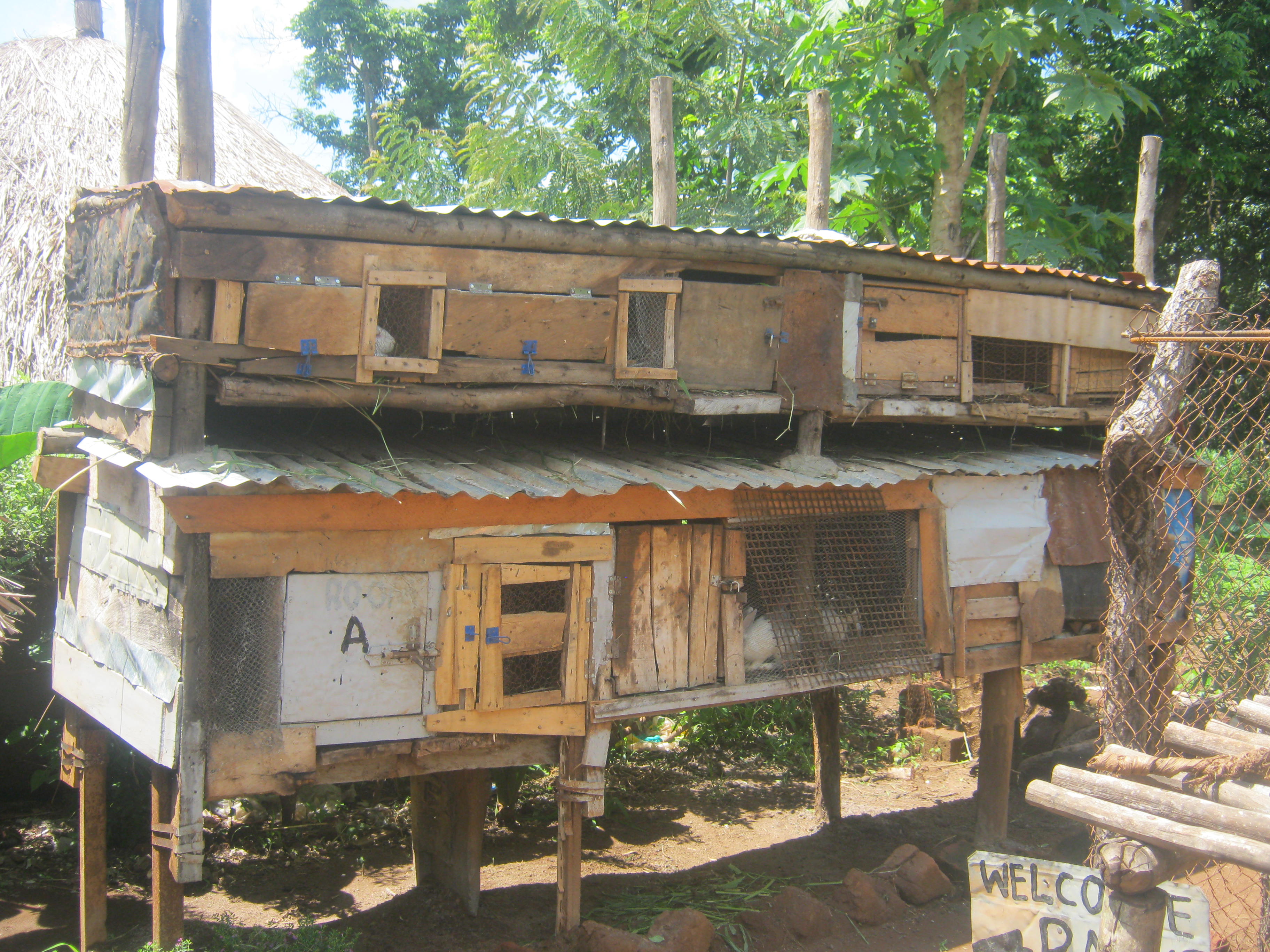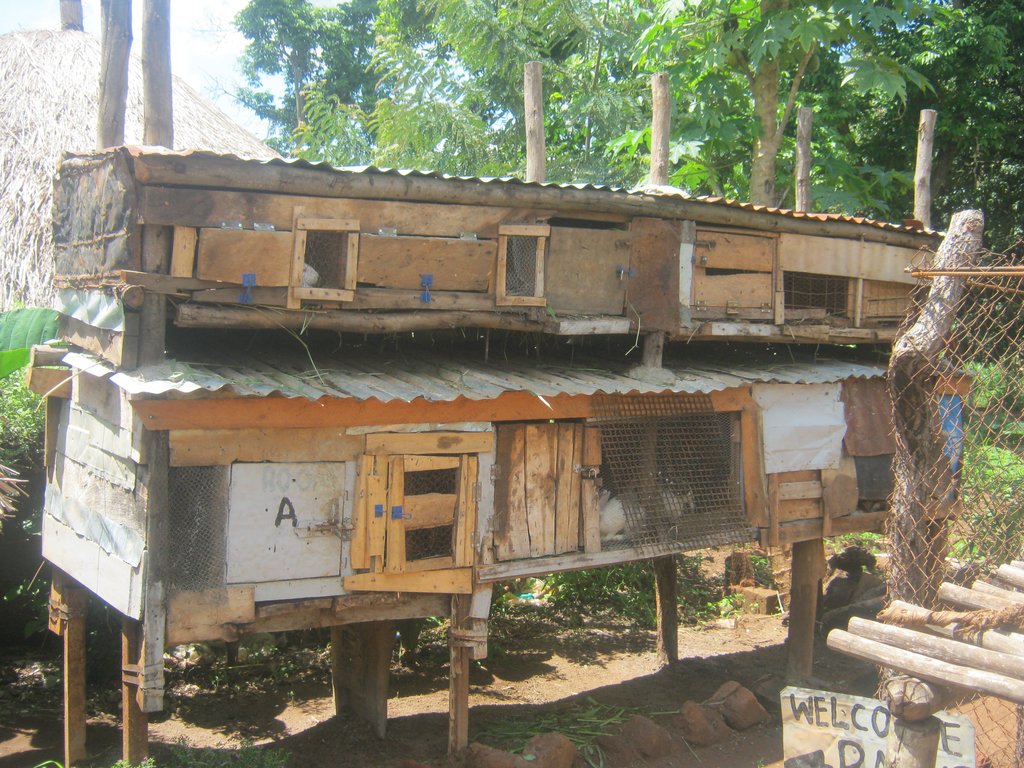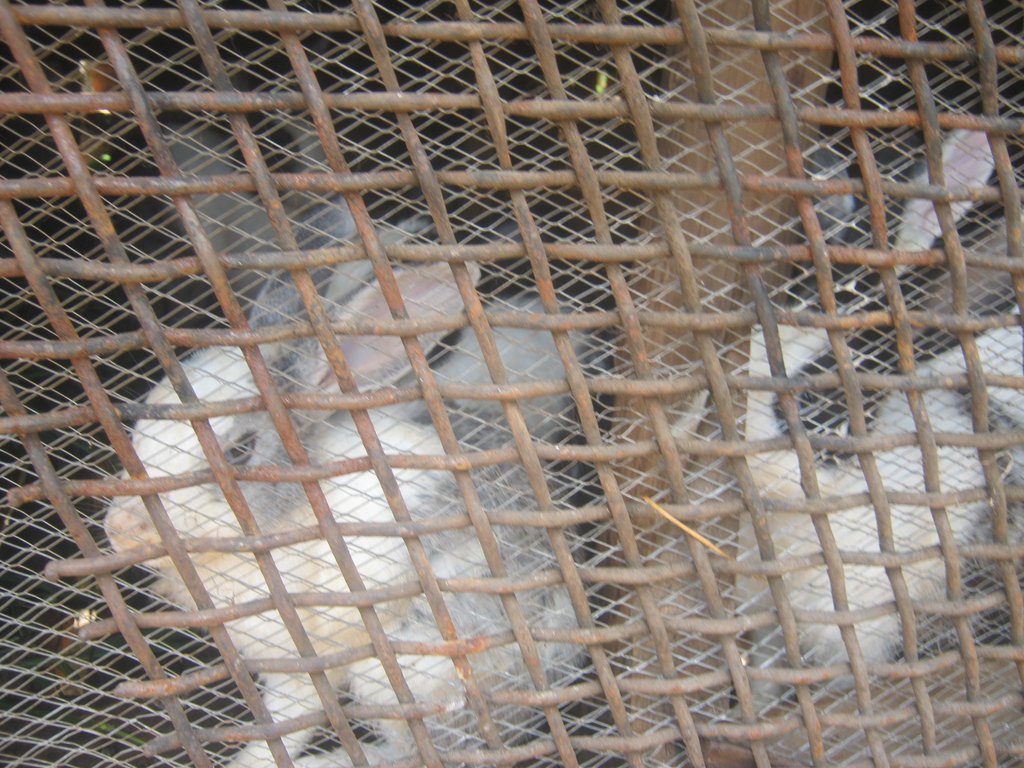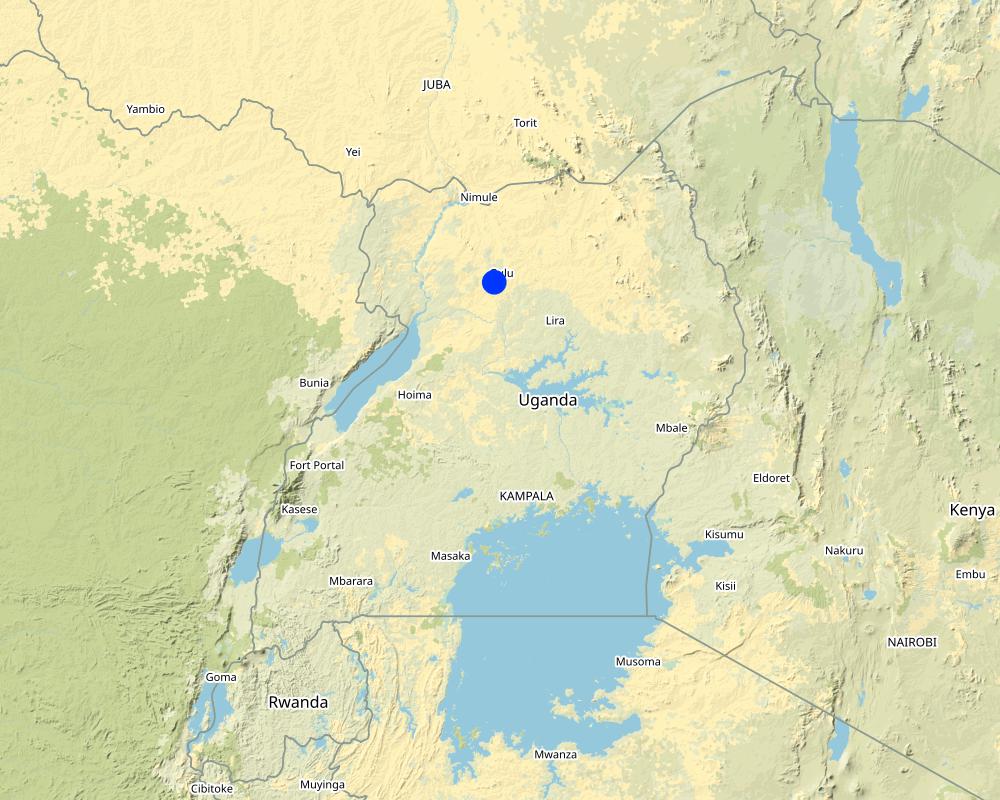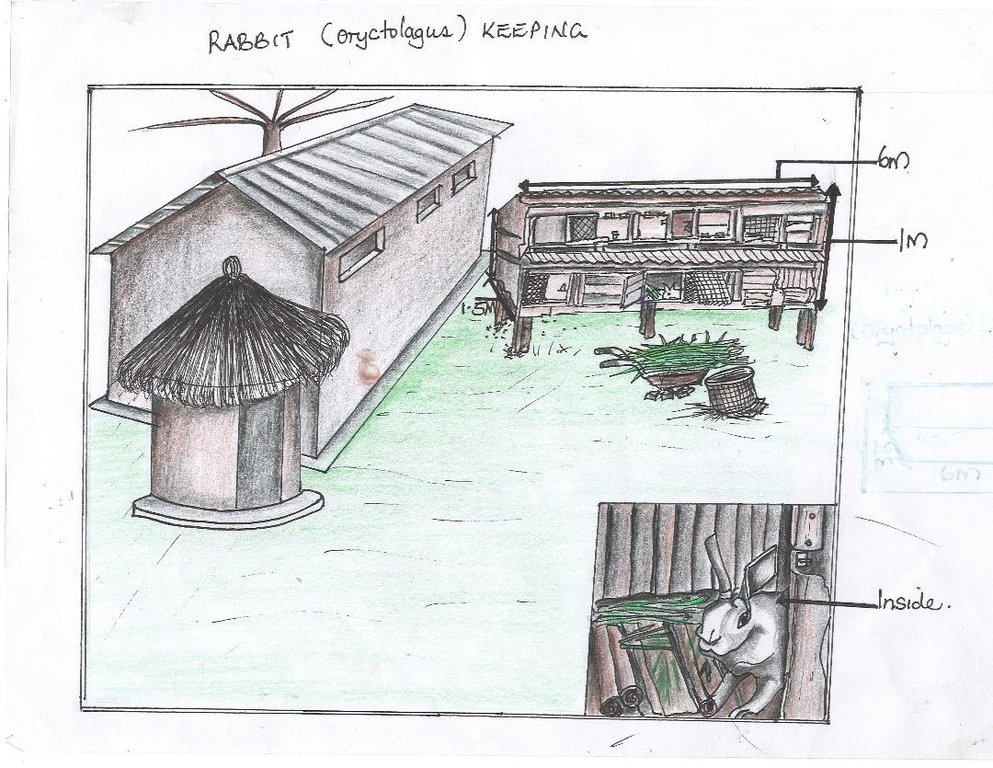Local Rabbit Keeping for Manure Production and Household Income [Uganda]
- Creation:
- Update:
- Compiler: betty adoch
- Editors: JOY TUKAHIRWA, Kamugisha Rick Nelson, Bernard Fungo
- Reviewers: Drake Mubiru, Udo Höggel
Gwoko Apwoyo pi cetgi me medo moc ngom
technologies_2890 - Uganda
View sections
Expand all Collapse all1. General information
1.2 Contact details of resource persons and institutions involved in the assessment and documentation of the Technology
Key resource person(s)
land user:
Onen Geoffrey
0793874904 / 0776492280
onen@yahoorocket.com
Ongako Farmers group
Omoro District, Ongako Subcounty, Kal Parish, Kal Village
Uganda
Name of project which facilitated the documentation/ evaluation of the Technology (if relevant)
Scaling-up SLM practices by smallholder farmers (IFAD)Name of the institution(s) which facilitated the documentation/ evaluation of the Technology (if relevant)
Uganda Landcare Network (ULN) - Uganda1.3 Conditions regarding the use of data documented through WOCAT
When were the data compiled (in the field)?
24/05/2017
The compiler and key resource person(s) accept the conditions regarding the use of data documented through WOCAT:
Yes
1.4 Declaration on sustainability of the described Technology
Is the Technology described here problematic with regard to land degradation, so that it cannot be declared a sustainable land management technology?
No
2. Description of the SLM Technology
2.1 Short description of the Technology
Definition of the Technology:
Local rabbits are kept in a shade made of wood, iron sheet and wire mesh for manure production with the aim of obtaining animal manure for soil fertility improvement thus increasing vegetable and fruits production and household income.
2.2 Detailed description of the Technology
Description:
Local rabbit keeping for manure production is a common practice promoted by farmers in Northern Uganda with the aim of obtaining animal manure for soil fertility improvement, increasing agricultural production and for securing household income.
Through the promotion of this technology the farmer uses animal manure because soils have low fertility, coupled with low productivity and hence low crop yields caused by degradation due to mono-culture, overgrazing and bush burning.
To obtain animal manure, local rabbits are kept within the compound for easy monitoring, minimum protection against predators and easy collection of manure. After manure is collected, it is filled into a decomposing pit. From there the manure is later applied to agricultural fields, vegetable and fruit gardens.
Important to note is that this technology is appropriate for small scale farmers with land size holding of 0.5-2 acres. it requires little amount of money at the time of establishment, it is not labour intensive and provides high nutrient manure since the rabbits are fed mainly on local feeds.
Usually manure is collected around the rabbit house on a weekly basis to be used as compost manure which is then applied to the garden. Following steps are required : Site clearing, collecting manure and digging compost pits for manure decomposition and manure application to the garden. Material required is timber, wheel barrows, hoes, nails, wire mesh and iron sheets. The compost manure pit is dug to 1 meter depth and 1 meter width. Rabbit dung is collected to fill up the pit.
To maintain the technology, land users need to clear the bush around the house for easy collection of the dung and turning the decomposing manure weekly for proper decomposition.
Usually it takes one month for a pit to fill up and the decomposition period is three months. The compost manure is then collected using a wheelbarrow and spread into the vegetables and fruits gardens of lemon grass, green peas, green pepper and fruits (tangerine, oranges).
After applying on his garden, the farmer continues to collect the surplus manure which he sells to other farmers at a rate of 2,000 shillings per spade of organic manure. This practice is usually appreciated by land users because it enhances soil fertility, increases crop production and rehabilitates badly degraded land by adding manure nutrients to the soil.
What is not liked about this technology is that the manure takes somewhat a long time to accumulate due to the small number of rabbits kept in addition to long time to decompose for application on the garden.
2.3 Photos of the Technology
2.4 Videos of the Technology
Comments, short description:
Video showing rabbit keeping for increased manure production and household income.
Date:
24/05/2017
Location:
Kal Village , Kal Parish, Ongako Subcounty,Omoro District, Northern Uganda
Name of videographer:
Betty Adoch
2.5 Country/ region/ locations where the Technology has been applied and which are covered by this assessment
Country:
Uganda
Region/ State/ Province:
Northern Uganda.
Further specification of location:
Kal Village, Kal Parish, Ongako Subcounty,Omoro District, Northern Uganda
Comments:
Kal Village, Kal Parish, Ongako Subcounty, Omoro District, Northern Uganda
Map
×2.6 Date of implementation
Indicate year of implementation:
2016
2.7 Introduction of the Technology
Specify how the Technology was introduced:
- through land users' innovation
- through projects/ external interventions
Comments (type of project, etc.):
Local rabbit keeping project for animal manure
3. Classification of the SLM Technology
3.1 Main purpose(s) of the Technology
- improve production
- reduce, prevent, restore land degradation
- preserve/ improve biodiversity
- create beneficial economic impact
3.2 Current land use type(s) where the Technology is applied

Cropland
- Annual cropping
- Perennial (non-woody) cropping
- Tree and shrub cropping
Main crops (cash and food crops):
Vegetables, fruits

Unproductive land
Specify:
Degraded lands
If land use has changed due to the implementation of the Technology, indicate land use before implementation of the Technology:
Cereals cropland and grazing fields.
3.3 Further information about land use
Water supply for the land on which the Technology is applied:
- rainfed
Number of growing seasons per year:
- 1
3.4 SLM group to which the Technology belongs
- integrated crop-livestock management
- beekeeping, aquaculture, poultry, rabbit farming, silkworm farming, etc.
3.5 Spread of the Technology
Specify the spread of the Technology:
- applied at specific points/ concentrated on a small area
3.6 SLM measures comprising the Technology

agronomic measures
- A2: Organic matter/ soil fertility

structural measures
- S9: Shelters for plants and animals

management measures
- M1: Change of land use type
3.7 Main types of land degradation addressed by the Technology

soil erosion by water
- Wt: loss of topsoil/ surface erosion

chemical soil deterioration
- Cn: fertility decline and reduced organic matter content (not caused by erosion)

physical soil deterioration
- Pu: loss of bio-productive function due to other activities

biological degradation
- Bc: reduction of vegetation cover
- Bh: loss of habitats
- Bq: quantity/ biomass decline
Comments:
The application of this technology helps repairing the soil from human-induced degradation.
3.8 Prevention, reduction, or restoration of land degradation
Specify the goal of the Technology with regard to land degradation:
- prevent land degradation
- reduce land degradation
4. Technical specifications, implementation activities, inputs, and costs
4.1 Technical drawing of the Technology
4.2 Technical specifications/ explanations of technical drawing
The technical drawing shows a rabbit house (hutch). This hutch was made simple and affordable to the farmer. The hutch was constructed around the compound for easy monitoring from danger by the farmer. The farmer constructed the hutch out of wood, iron sheets for the roofing and a wire mesh door that can be opened and closed.
However, when constructing a hutch, the measurements tend to vary depending on the number of rabbits a farmer wants to rear.
The technical drawing shows that the width of the hutch is six (6) meters and having a depth of 1,5 metres. The wall of the hutch is made of wood of about 1 meter high supported by a raised platform. That platform offers protection against dangerous reptiles such as snakes that prey on rabbits.
The hutch has lower and upper levels, partitioned into smaller rooms big enough to accommodate a pair of rabbits. The sizes of the rooms are four times bigger than the size of the rabbit's length. This is to provide ample space for the rabbit to run around and stretch as well as a place to hide while playing.
A hutch is constructed in a way that protects the rabbit from adverse weather conditions such a too windy weather that usually kills or makes the rabbit to become too sick as well as to provide shade to the rabbits.
However, hutches can be difficult to clean and also rabbits may be able to escape if the wire mesh isn't tightly secured.
4.3 General information regarding the calculation of inputs and costs
Specify how costs and inputs were calculated:
- per Technology area
Indicate size and area unit:
2 acres
other/ national currency (specify):
UGX
Indicate exchange rate from USD to local currency (if relevant): 1 USD =:
3500.0
Indicate average wage cost of hired labour per day:
3000shs
4.4 Establishment activities
| Activity | Type of measure | Timing | |
|---|---|---|---|
| 1. | Site clearing | Agronomic | Dry and wet season |
| 2. | Digging pits | Structural | Dry and wet season |
| 3. | Collecting rabbit dung | Management | Dry and Wet season |
| 4. | Pilling the dung in the pit | Management | Dry and Wet season |
| 5. | Applying manures to the garden | Agronomic | Wet season |
| 6. | Constructing the hutch | Structural | Dry and Wet season |
Comments:
Easy to establish the technology because it requires less capital.
4.5 Costs and inputs needed for establishment
| Specify input | Unit | Quantity | Costs per Unit | Total costs per input | % of costs borne by land users | |
|---|---|---|---|---|---|---|
| Labour | Labour | persons day | 2.0 | 3500.0 | 7000.0 | 100.0 |
| Equipment | Hoes | piece | 3.0 | 12000.0 | 36000.0 | 100.0 |
| Equipment | Wheelbarrows | piece | 1.0 | 90000.0 | 90000.0 | 100.0 |
| Equipment | Spade | piece | 1.0 | 30000.0 | 30000.0 | 100.0 |
| Construction material | Nails | pics | 30.0 | 500.0 | 15000.0 | 100.0 |
| Construction material | Poles | pics | 10.0 | 5000.0 | 50000.0 | 100.0 |
| Construction material | Wire mesh | Roll | 1.0 | 30000.0 | 30000.0 | 100.0 |
| Construction material | Iron sheets | pics | 2.0 | 32000.0 | 64000.0 | 100.0 |
| Construction material | Timber | pics | 10.0 | 12000.0 | 120000.0 | 100.0 |
| Total costs for establishment of the Technology | 442000.0 | |||||
Comments:
Land user can afford to pay the workers during during construction, compost manure making and labour for transporting the manures to the garden.
4.6 Maintenance/ recurrent activities
| Activity | Type of measure | Timing/ frequency | |
|---|---|---|---|
| 1. | Turning the compost | Management | During dry and wet season |
| 2. | Cleaning the hutch | Management | During dry and wet season |
| 3. | Digging around the hutch | Management | During dry and wet season |
4.7 Costs and inputs needed for maintenance/ recurrent activities (per year)
| Specify input | Unit | Quantity | Costs per Unit | Total costs per input | % of costs borne by land users | |
|---|---|---|---|---|---|---|
| Labour | Clearing around the hutch | perso per dayn | 1.0 | 3000.0 | 3000.0 | 100.0 |
| Labour | Cleaning the hutch | person per day | 4.0 | 3000.0 | 12000.0 | 100.0 |
| Labour | Clearing around the manure pit | person per day | 1.0 | 3000.0 | 3000.0 | 100.0 |
| Labour | Adding manure to the garden | persons per day | 1.0 | 3000.0 | 3000.0 | 100.0 |
| Equipment | Hoe | pic | 1.0 | 12000.0 | 12000.0 | 100.0 |
| Equipment | Spade | pic | 1.0 | 30000.0 | 30000.0 | 100.0 |
| Equipment | Wheelbarrow | pic | 1.0 | 150000.0 | 150000.0 | 100.0 |
| Equipment | Hard broom | pic | 1.0 | 500.0 | 500.0 | 100.0 |
| Total costs for maintenance of the Technology | 213500.0 | |||||
Comments:
Maintenance activities do not require much capital.
4.8 Most important factors affecting the costs
Describe the most determinate factors affecting the costs:
Inputs such as timber, wheel barrows, hoes, nails , wire mesh and iron sheets affect costs most.
5. Natural and human environment
5.1 Climate
Annual rainfall
- < 250 mm
- 251-500 mm
- 501-750 mm
- 751-1,000 mm
- 1,001-1,500 mm
- 1,501-2,000 mm
- 2,001-3,000 mm
- 3,001-4,000 mm
- > 4,000 mm
Specify average annual rainfall (if known), in mm:
1500.00
Specifications/ comments on rainfall:
Rainy seasons from april, may, june, july, august, september and october. Dry seasons from november, december, january, febuary and march.
Indicate the name of the reference meteorological station considered:
Gulu weather station.
Agro-climatic zone
- sub-humid
Tropical savanna climate
5.2 Topography
Slopes on average:
- flat (0-2%)
- gentle (3-5%)
- moderate (6-10%)
- rolling (11-15%)
- hilly (16-30%)
- steep (31-60%)
- very steep (>60%)
Landforms:
- plateau/plains
- ridges
- mountain slopes
- hill slopes
- footslopes
- valley floors
Altitudinal zone:
- 0-100 m a.s.l.
- 101-500 m a.s.l.
- 501-1,000 m a.s.l.
- 1,001-1,500 m a.s.l.
- 1,501-2,000 m a.s.l.
- 2,001-2,500 m a.s.l.
- 2,501-3,000 m a.s.l.
- 3,001-4,000 m a.s.l.
- > 4,000 m a.s.l.
Indicate if the Technology is specifically applied in:
- not relevant
5.3 Soils
Soil depth on average:
- very shallow (0-20 cm)
- shallow (21-50 cm)
- moderately deep (51-80 cm)
- deep (81-120 cm)
- very deep (> 120 cm)
Soil texture (topsoil):
- medium (loamy, silty)
Soil texture (> 20 cm below surface):
- medium (loamy, silty)
Topsoil organic matter:
- medium (1-3%)
5.4 Water availability and quality
Ground water table:
5-50 m
Availability of surface water:
good
Water quality (untreated):
good drinking water
Is water salinity a problem?
No
Is flooding of the area occurring?
No
5.5 Biodiversity
Species diversity:
- high
Habitat diversity:
- high
5.6 Characteristics of land users applying the Technology
Sedentary or nomadic:
- Sedentary
Market orientation of production system:
- mixed (subsistence/ commercial
Off-farm income:
- less than 10% of all income
Relative level of wealth:
- average
Individuals or groups:
- individual/ household
Level of mechanization:
- manual work
Gender:
- women
- men
Age of land users:
- youth
- middle-aged
5.7 Average area of land owned or leased by land users applying the Technology
- < 0.5 ha
- 0.5-1 ha
- 1-2 ha
- 2-5 ha
- 5-15 ha
- 15-50 ha
- 50-100 ha
- 100-500 ha
- 500-1,000 ha
- 1,000-10,000 ha
- > 10,000 ha
Is this considered small-, medium- or large-scale (referring to local context)?
- small-scale
5.8 Land ownership, land use rights, and water use rights
Land ownership:
- individual, not titled
Land use rights:
- individual
Water use rights:
- communal (organized)
5.9 Access to services and infrastructure
health:
- poor
- moderate
- good
education:
- poor
- moderate
- good
technical assistance:
- poor
- moderate
- good
employment (e.g. off-farm):
- poor
- moderate
- good
markets:
- poor
- moderate
- good
energy:
- poor
- moderate
- good
roads and transport:
- poor
- moderate
- good
drinking water and sanitation:
- poor
- moderate
- good
financial services:
- poor
- moderate
- good
6. Impacts and concluding statements
6.1 On-site impacts the Technology has shown
Socio-economic impacts
Production
crop production
Comments/ specify:
Manure adds nutrients into the soil thus increasing crop productions
crop quality
Comments/ specify:
Manure add nutrients to the soil fertile soils improving crop quality
land management
Comments/ specify:
Due to application of manure which is locally obtained.
Income and costs
farm income
Comments/ specify:
Some of the surplus manure is sold to generate income @ spade at UGX 2000 to the neighbourhood
Ecological impacts
Biodiversity: vegetation, animals
Vegetation cover
Quantity before SLM:
low quantity before SLM
Quantity after SLM:
high quantity after SLM
Comments/ specify:
Vegetable crop growing improved due to manure applications into the soil.
biomass/ above ground C
Comments/ specify:
Dense vegetation cover provides above ground carbon sink.
6.3 Exposure and sensitivity of the Technology to gradual climate change and climate-related extremes/ disasters (as perceived by land users)
Gradual climate change
Gradual climate change
| Season | Type of climatic change/ extreme | How does the Technology cope with it? | |
|---|---|---|---|
| annual temperature | increase | moderately | |
| annual rainfall | decrease | moderately |
Climate-related extremes (disasters)
Biological disasters
| How does the Technology cope with it? | |
|---|---|
| epidemic diseases | not well |
6.4 Cost-benefit analysis
How do the benefits compare with the establishment costs (from land users’ perspective)?
Short-term returns:
positive
Long-term returns:
positive
How do the benefits compare with the maintenance/ recurrent costs (from land users' perspective)?
Short-term returns:
positive
Long-term returns:
positive
6.5 Adoption of the Technology
- single cases/ experimental
Of all those who have adopted the Technology, how many have did so spontaneously, i.e. without receiving any material incentives/ payments?
- 90-100%
6.6 Adaptation
Has the Technology been modified recently to adapt to changing conditions?
Yes
If yes, indicate to which changing conditions it was adapted:
- changing markets
Specify adaptation of the Technology (design, material/ species, etc.):
Improved rabbit species being reared by the farmers that fetch high market prices.
6.7 Strengths/ advantages/ opportunities of the Technology
| Strengths/ advantages/ opportunities in the land user’s view |
|---|
| The technology is good at providing locally available materials such rabbit dung/animal manure that is less cost intensive and locally obtained. |
| Good at improving soil fertility by applying manure, rewarding in the short, medium and long term and can be replicated by other small scale farmers in other areas. |
| Provides income after sale of manure. |
| Very appropriate for men and children/youth since it does not involve a lot of moving from one place to another for feeds. |
| Strengths/ advantages/ opportunities in the compiler’s or other key resource person’s view |
|---|
| The technology is multipurpose (good at improving soil fertility by applying manure, provides income after sale of manure). |
| Easy to replicate. |
6.8 Weaknesses/ disadvantages/ risks of the Technology and ways of overcoming them
| Weaknesses/ disadvantages/ risks in the land user’s view | How can they be overcome? |
|---|---|
| Leaching due to excessive rainfall. | Dig the manure pit under shade/shelter. |
| Liked by thieves. | Fencing, provision of security. |
| Rabbits consume lots of feeds. | Grow relevant local feeds near the homestead such as grass, maize plant. |
| Weaknesses/ disadvantages/ risks in the compiler’s or other key resource person’s view | How can they be overcome? |
|---|---|
| Negative attitude by other community members. | Involve them in the process of manure preparation and hutch constructions. |
| Long period required for manure to decompose. | Dig pit under shade for fast cooling of the compost and enhancement of decomposition. |
| Low rabbit dung collection for manure since they are kept in less numbers. | Expand the number of rabbits to generate manure. |
7. References and links
7.1 Methods/ sources of information
- field visits, field surveys
1
- interviews with land users
1
7.2 References to available publications
Title, author, year, ISBN:
The potential of rabbit production in improving household incomes in Nankoma Sub-county, Bugiri District, Uganda E K Ndyomugyenyi and O D Otiengino
Available from where? Costs?
https://www.researchgate.net/publication/289674867_Ndyomugyenyi_E_K_and_Otiengino_O_D_2013_The_potential_of_rabbit_production_in_improving_household_incomes_in_Nankoma_Sub-county_Bugiri_District_Uganda_Livestock_Research_for_Rural_Development_25_8_htt
7.3 Links to relevant information which is available online
Title/ description:
Rabbit Farming In Uganda, Rearing Tips, Farmers Association, Market, Urine, Feeds & Cages
URL:
https://www.aboutuganda.com/agriculture/rabbit-farming-in-uganda
Links and modules
Expand all Collapse allLinks
No links
Modules
No modules


